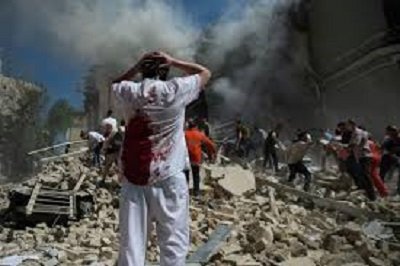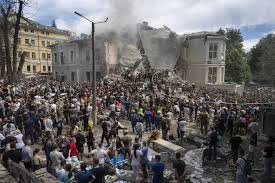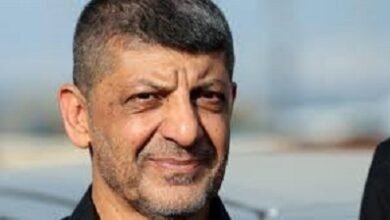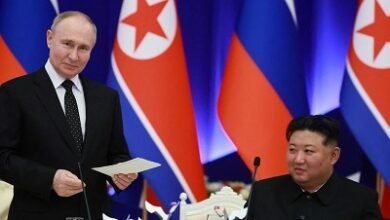Russian Kh-101 cruise missile hit the Okhmatdyt Children’s Hospital-Kyiv !!!
By S K Singh : Editor-In-Chief

WAR-REPORT :- A Russian Kh-101 cruise missile hit the Okhmatdyt Children’s Hospital in central Kyiv during a wider series of missile strikes targeting critical Ukrainian infrastructure throughout the day on July 8. Ukrainian Air Force Commander Lieutenant General Mykola Oleshchuk stated that Russian forces conducted two rounds of combined missile strikes on July 8—first launching four Kh-101 cruise missiles from Saratov Oblast and two Iskander-M ballistic missiles from occupied Crimea and Kursk Oblast overnight on July 7 to 8, and then launching a second wave of missiles, including one Kh-47 Kinzhal aeroballistic missile, four Iskander-M ballistic missiles, one 3M22 Zircon cruise missile, 13 Kh-101 cruise missiles, 14 Kalibr cruise missiles, two Kh-22 cruise missiles, and three Kh-59/69 guided air missiles around 1000 local time on July 8.
Ukrainian air defense shot down two Kh-101s in the first wave, and one Kh-47, three Iskanders, 11 Kh-101s, 12 Kalibrs, and three Kh-59/69s during the second wave. Ukrainian President Volodymyr Zelensky stated that Russian forces targeted residential and other civilian infrastructure in Kyiv, Dnipro, Kryvyi Rih, Slovyansk, and Kramatorsk cities.
Footage taken by a bystander in Kyiv City shows the second before a Russian missile struck the Okhmatdyt Children’s Hospital—Ukraine’s largest pediatric hospital that treats thousands of patients, including cancer cases, daily.

The footage clearly shows a single missile flying at a sharp downward trajectory before making contact with the hospital building. Ukraine’s Security Service (SBU) conducted a preliminary investigation of the blast site at Okhmatdyt and concluded that Russian forces used a Kh-101 missile to strike the hospital. The Okhmatdyt Children’s Hospital published footage showing extensive damage to medical facilities on the premises. Falling debris from Russian missiles also struck the Isida Maternity Hospital in western Kyiv City after the initial strike on the Okhmatdyt hospital, and Russian missile strikes also damaged residential infrastructure elsewhere both in Kyiv and Dnipro cities.
The Ukrainian Ministry of Internal Affairs has confirmed 22 deaths and 74 injured in Kyiv City and 11 deaths and 64 injured within Dnipropetrovsk Oblast as of the time of this publication. Zelensky announced that Ukraine is convening an emergency session of the United Nations Security Council (UNSC) in response to these Russian strikes. Russia is currently the president of the UNSC.
The July 8 Russian missile strikes likely employed a new and noteworthy tactic to maximize the damage from such strike series. Former Ukrainian Air Forces Spokesperson Colonel Yuriy Ihnat stated following the strikes on July 8 that Russian forces are constantly improving their reconnaissance and strike drone capabilities and the efficacy of both cruise and ballistic missiles, noting that during the July 8 strike Russian cruise missiles flew at “extremely low” altitudes.

Ihnat noted that in some cases, Ukrainian air defense forces had to attempt to intercept cruise missiles flying as low as 50 meters above the ground. Ukrainian air defenses have historically had high shoot-down rates for certain types of cruise missiles, particularly the older Kh-101 variety, but Ihnat’s suggestion of Russian forces launching cruise missile strikes at such low altitudes indicates that Russian forces may have innovated their tactics and/or technology somewhat to inflict maximum damage on Ukrainian infrastructure by giving Ukrainian air defense practically no time to respond until the missile is already within close range of the ground.
Ihnat noted that Russian forces are reducing the electromagnetic signatures of the drones until the last possible moment to prevent their detection by Ukrainian forces, which Ihnat noted means that by the time Ukrainian forces detect the drone, the missile the drone was guiding could already be close to the target point. Russia has consistently adapted the strike packages it uses against Ukraine to take advantage of Ukraine’s air defense shortages, and the July 8 strikes represent a new and adapted strike package that Ukraine will need to learn to respond to with requisite levels of Western-provided air defense systems.








